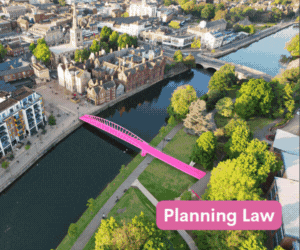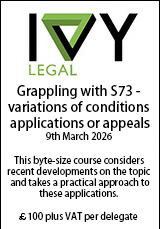Time limits and CIL
- Details
Christopher Cant looks at the lessons to be learned from a recent judicial review challenge over a council’s decision to issue and serve a CIL (Community Infrastructure Levy) stop notice.
The recent decision in Lee Jones v Shropshire Council [2025] EWHC 365 (Admin) is interesting for what it does not discuss as for what it does. The outcome can be recorded shortly. It is possible for a collecting authority to issue a stop notice under the CIL regime even after the expiry of six years from the date when the CIL liability fell due and even when neither a liability order nor a judgment debt has been obtained before the issue of the stop notice.
The focus of the judgment understandably is on whether a stop notice constitutes an action to recover a sum recoverable by virtue of any enactment within section 9(1) of the Limitation Act 1980. It does not explore the wider issue as to how the provisions of the 1980 Act apply to a CIL liability and in particular why in the circumstances of this case after the expiry of six years there was still a subsisting CIL liability justifying the issue of a valid stop notice.
1. History of this CIL issue
Captain Jones is the owner of Mayfield Farm. He has the benefit of a planning permission authorising him to construct there a detached house with triple garage granted by Shropshire Council on 5th June 2015. This is a self-build project and so would have qualified for the self-build housing exemption if the then statutory pre-conditions had been satisfied. Unfortunately they were held not to have been. Captain Jones had e-mailed the Council officer that he had been dealing with over the section 106 planning agreement on 10th July 20 with a point on payment of a contribution under that agreement and in that e-mail stated that site clearance works would commence on the site the following day. On a statutory appeal under regulation 117 it was held that this e-mail was a valid commencement notice. Service of a valid commencement notice was then one of the statutory pre-conditions to the application of the exemption. This decision was firmly quashed by the High Court in R (oao Shropshire Council) v Secretary of Sate for Communities and Local Government and Captain Jones [2019] EWHC 16 (Admin) on the ground that a Form 6 had not been used and the particulars required had not been supplied. It was an example of the strict and formalistic nature of the CIL regime.
As the development had commenced it left Shropshire Council free to continue with requiring the payment of CIL arising from the development amounting to £36,861 plus late payment interest. On 25th February 2021 the Council applied to Telford Magistrates for a liability order under regulation 97 of the 2010 Regulations. This order was made on 1st July 2021. However, Captain Jones appealed by way of case stated and the appeal was allowed on 5th April 2022 by Steyn J. in Lee Jones v Shropshire Council [2022] EWHC 1103 (Admin). Shropshire Council could not then make a fresh application because more than six years had passed from the commencement of the development and regulation 97(3) prevents such an application after the expiry of that six year period.
Notwithstanding the passage of time the development had not been completed so on 11th May 2022 Shropshire Council served a CIL warning notice under regulation 89(1) requiring payment of £39,561.43 (being the original CIL liability and late payment interest). A second warning notice was served on 10th September 2022 and then on 23rd September 2022 a stop notice was served.
2. Challenge to the stop notice
There is a limited right of appeal in regulation 119 against a stop notice. The ground of appeal has to be either that no warning notice was given or the development had not commenced. Neither applied in this case. In consequence to challenge the stop notice Captain Jones had to apply by way of judicial review which claim was issued on 11th November 2022. Leave was initially refused but granted on appeal on 18th October 2022. The ground for the claim was that Shropshire Council’s ability to issue a stop notice was time barred as more than six years had passed since the commencement of the development. The contention was that section 9(1) of the Limitation Act 1980 (“the 1980 Act”) applied to the service of the stop notice. This applies a six year limitation to an action to recover any sum recoverable by virtue of an enactment. The single question considered and decided in these proceedings was whether a stop notice is subject to the time limit imposed by section 9(1).
There appear to have been two live issues argued in this context. One was whether a stop notice constitutes an action within the section 9(1). The second related to whether if a stop notice is such an action it is one to recover any sum. The arguments concerning this second issue were not set out but probably focused on the immediate outcome of the service of a stop notice being the stopping of a development rather than a judicial decision that a sum of money must be paid. The learned judge stated that he saw some force in the submissions made on behalf of each party on this second issue but did not need to decide it (para. 72).
On the first issue as to whether a stop notice is an action within section 9(1) it was argued for the claimant that the administrative action of issuing a stop notice is such an action. Reliance was placed both on the natural meaning of the words and the wider meaning of “action” contained in section 38(1) of the 1980 Act which includes “any proceedings in a court of law including an ecclesiastical court (and see subsection (11) below)”. Section 38(11) provides that references to action “do not include any method of recovery of a sum recoverable” under two sets of statutory provisions relating to social security and one relating to tax credits. It was argued that this indicated that methods of recovery in other statutory contexts did constitute an action within section 9(1).
Further support was claimed from the Court of Appeal decision in China v Harrow UDC [1954] 1 QB 178 which held that an application for a distress warrant in respect of unpaid domestic rates made more than six years after the rates fell due was time barred by section 2(1)(d) of the Limitation Act 1939 (“the 1939 Act”) (section 2(1)(d) being the predecessor to section 9(1) of the 1980 Act). No action lay for the recovery of rates as a debt but there had to be a demand notice for the unpaid rates and the application required a judicial decision. It was held that the application constituted proceedings and so was within the operation of section 2(1)(d) of the 1939 Act and time-barred.
The judge did not consider that the China decision had a direct bearing on this case as the China decision concerned an application involving court proceedings. Further he did not consider that section 38(11) did more than ensure that the specified methods of recovery were not within the operation of section 9(1) but did not mean that any other method of recovery was (para. 60). He also did not derive any assistance from the line of authorities relating to the bar on actions or proceedings when a winding up order has been made which hold that a distraint is a proceeding for such purpose (para. 65).
It was argued on behalf of the claimant that if the stop notice was not time-barred then a developer would be exposed to the risk of enforcement proceedings for the recovery of CIL indefinitely. The judge considered that it was likely that the power to serve a stop notice would be exercised timely. It was evident to him that there was a “broader policy objective that enforcement of payment of CIL due in respect of development should be effective, so that the funds are available to meet the cost of local community infrastructure..” (para. 67).
Although there is no time limit applicable to the service of a stop notice the judge did suggest that if the authority was intending to serve a stop notice in respect of “a modest and residual unpaid sum of CIL many years after the development had been largely carried out” then the developer could question whether the stop notice was expedient and that could be a ground for challenge by way of judicial review proceedings (para. 71). The likelihood though is that the service of a stop notice some years after the commencement of the development will be in respect of larger developments.
The outcome of this decision is that a local authority can serve a stop notice after the expiry of six years from the date the CIL fell due. No time limit was considered to apply although there may be as discussed below a twelve year time limit. What was not expressly discussed in the judgment was why the CIL liability was still subsisting after the expiry of the six year period from when it fell due. This requires a wider consideration of limitation periods and CIL.
3. CIL and limitation periods in general
The only time limit expressly stated in the CIL regime is in regulation 97(3) of the Community Infrastructure Levy Regulations 2010. This prevents the making of applications to a magistrates court for a liability order more than six years after the CIL liability the subject of the application fell due. A liability order is not a money judgment (reg. 97(10)) but a pre-condition which has to be satisfied before the authority is able to employ certain statutory methods of recovery – distress (reg. 98); committal (reg. 100); charging orders (reg. 103); and the amount of the liability order being deemed to be a debt for bankruptcy petitions and winding-up petitions (reg. 105). Once made there is no time limit applying to when the authority has to act. So far as I am aware there is no CIL decision on this point but this point arose in respect of council tax in the Court of Appeal decision in Bolsover DC v Ashfield Nominees [2010] EWCA Civ 1129.
Council tax has an enforcement regime (Part VI of the Council Tax (Administration and Enforcement) Regulations 1992) which bears some similarities to CIL enforcement. Regulation 34 of the 1992 Regulations provides for an application for a liability order which has a similar role to a liability order in the CIL regime. The issue in the Bolsover case was whether a winding-up petition could be validly presented based on unpaid council tax more than six years after the making of a liability order relating to the same sum. It was argued that no recovery action could be taken after the expiry of six years from the making of the liability order. This was based on section 24 of the 1980 Act which barred an action brought upon a judgment after the expiry of such a period. It was held that section 24 only applies to rare claims seeking a second judgment based on an earlier judgment but not to steps to enforce the earlier judgment. The consequence is that no time bar applies to subsequent steps of enforcement once a liability order in respect of unpaid council tax has been made.
In the judgment of Lloyd LJ (with whom the other two Lord Justices agreed) he compared the enforcement regime for council tax with that for non-domestic rates (Non-Domestic Rating (Collection and Enforcement) (Local Lists) Regulations 1989). The two regimes differed. The council tax enforcement regime has the one option of an application for a liability order. The non-domestic rates enforcement regime has two options which bears some similarity with the CIL enforcement regime. A choice has to be made between applying in the magistrates court for a liability order or claiming in an appropriate court for a money judgment. An authority cannot pursue both courses of action but has to choose between them. Lloyd LJ considered that section 9 of the 1980 Act would apply to an ordinary civil claim for unpaid non-domestic rates so that if not made within six years of falling due such a claim can no longer be made (para. 17). Once a money judgment is obtained it is not subject to any further time limit. An application for a charging order can be made more than six years from the award (Lowsley v Forbes [1999] 1 AC 329) and a winding-up petition can be presented after more than six years (Ridgeway Motors (Isleworth) Limited v ALTS limited [2005] EWCA Civ 92 followed in the Bolsover case). Similarly an application for a liability order can only be made in relation to unpaid non-domestic rates falling due in the six year period preceding the making of the application. Lloyd LJ considered that what applied as regards enforcement after the making of a money judgment should also apply after the making of a liability order.
Applying the logic of Lloyd LJ in the Bolsover case to CIL enforcement once a liability order is made there are no time limits as regards methods of enforcement adopted by the authority. The only time limit is the six year period in which an application for a liability order has to be made. A claim in an appropriate court under regulation 106 is an action for a sum required by an enactment within section 9(1) and so such a claim cannot be made after the expiry of six years from the sum falling due.
This raises the question as to what is the position if more than six years have passed and no application for a liability order has been made and no claim for a money judgment. Captain Jones v Shropshire Council supra decides that a stop notice can be served and is not subject to a time limit. A warning notice must first be given before a stop notice. A pre-condition for a warning notice required by regulation 89(1) is that an amount of CIL has become payable but not been paid. The warning notice must be served on the person liable for the unpaid amount (reg. 89(3)(a)) as is also the case with the stop notice (reg. 90(3)(a)). This indicates that the CIL liability must still be due. What is to defeat the argument that in such circumstances it is not due as the possibility of a money judgment or a liability order is time barred? There are a number of counter arguments. The most obvious is that payment of the CIL liability is secured by a local land charge.
4. Local land charge
As well as the CIL enforcement provisions the payment of CIL is secured by a local land charge (reg. 66) which may be enforced pursuant to regulation 107. That method of enforcement is not subject to an express time limit but does require the consent of a county court and before granting consent the court must consider all the circumstances of the case and in particular any evidence before it as to whether any person would be likely to be unduly prejudiced by enforcement of the charge (reg. 107(5)). A factor in such consideration could possibly be the length of time between the CIL falling due and the date of the application. However, the mere passage of time is unlikely to be sufficient to justify refusing consent.
Although there is no express time limit is an application to enforce a CIL local land charge subject to a time limit imposed by the 1980 Act? As yet there is no CIL authority. The point has been considered in the context of statutory charges in favour of local authorities to recoup expenditure on matters such as private streets and working on dangerous buildings. In particular the issue of limitation periods was considered by the Court of Appeal in Poole Corporation v Moody [1945] KB 350. This decision is material as it was decided after the enactment of the 1939 Limitation Act which had introduced for the first time the six year time limit on actions to recover sums required by an enactment.
In that case Poole Corporation sought a declaration that it was entitled under section 13(1) Private Street Works Act 1892 to a charge over premises in respect of the cost of private street works executed under section 6 of that Act. The work had been completed on 18th March 1933 and the final apportionment was made on 27th June 1933. The defence was that section 2(1)(d) of the Limitation Act 1939 (now section 9(1) of the 1980 Act) applied because the proceedings were an action for the recovery of a sum required by an enactment. The six year period ran from 18th March 1933 and so the claim was time barred.
It was held that even if the claim constituted an action for recovery of a sum it was immaterial as it was a claim for other equitable relief as it sought “the ordinary equitable remedy of having the land sold and the proceeds applied in payment of the sum charged on the land” (Morton LJ at page 355). Section 2(7) of the 1939 Act (now section 36 of the 1980 Act) excluded the operation of section 2(1)(d) from any claim for other equitable relief. Morton LJ then went on to hold that the proceedings should be characterised as an action to recover any principal sum of money secured by a mortgage or other charge on property within section 18 of the 1939 Act (now section 20 of the 1980 Act). In consequence the applicable time limit was held to be twelve years which in that case had not expired and the defence failed. Separately it was held that the claim for interest on the principal was subject to a six year time limit (section 18(5) now section 20(5) of the 1980 Act).
The regime in the Private Street Works Act 1892 provides for both a charge to secure the recoupment of the cost of the works (section 13) and an ability to recover the amount due in a court of summary jurisdiction or by action as a simple contract debt (section 14). The CIL enforcement regime includes such methods of recovery as well as others. The decision in the Poole Corporation case indicates that there is a twelve year limitation period applicable to the enforcement of the CIL local land charge under regulation 107. The focus with CIL is at least a twelve year period and not exclusively a six year period.
5. Conclusions
(i) a CIL stop notice can be served under regulation 89 even if six years has passed since the CIL found due and no other steps have been taken to enforce the CIL liability.
(ii) the stop notice may be challenged by judicial review proceedings on the ground that it was not expedient to serve it.
(iii) any such challenge has to take into account that one of the principal objectives of the CIL regime is that enforcement should be effective so as to secure funds for local community infrastructure.
(iv) more usually an authority will adopt one of two routes of enforcement. One is to seek a money judgment under regulation 106. This will be subject to the six year time limit imposed by section 9 of the 1980 Act. If adopted it will preclude obtaining a liability order which in turn will preclude seeking a charging order.
(v) the alternative is to seek a liability order which then allows various methods of recovery to be pursued including a charging order. An application for a liability order must be made within six years of the CIL falling due (reg. 97(3)). If there are doubts as to the financial position of the person owing the CIL this may be the preferred course as it can lead to enforcement of the CIL liability against the property. If this route is being adopted because it is believed that in the magistrates court there will not be a cost order against the authority in the event of failure that outcome would seem unlikely in the light of the Supreme Court decision in Competition and Markets Authority v Flynn Pharma Limited [2022] UKSC 14 (para. 97).
(vi) separate from those enforcement routes there is the local land charge subsisting whether or not registered. This may be enforced under regulation 107 which is not subject to an express time limit but on the basis of Poole Corporation v Moody supra will probably be subject to the twelve year time limit in section 20 of the 1980 Act.
(vii) before enforcing the local land charge the consent of a county court has first to be obtained and delay in seeking to enforce the local land charge may in certain circumstances be a factor to be taken into account when determining whether any person would suffer prejudice if the local land charge is enforced.
Christopher Cant is a barrister at The Barrister Group.
Christopher.Cant©2025
Sponsored articles
Walker Morris supports Tower Hamlets Council in first known Remediation Contribution Order application issued by local authority
Unlocking legal talent
Lawyer (Planning and Regulatory)
Legal Director - Government and Public Sector
Contracts Lawyer
Locums
Poll







































